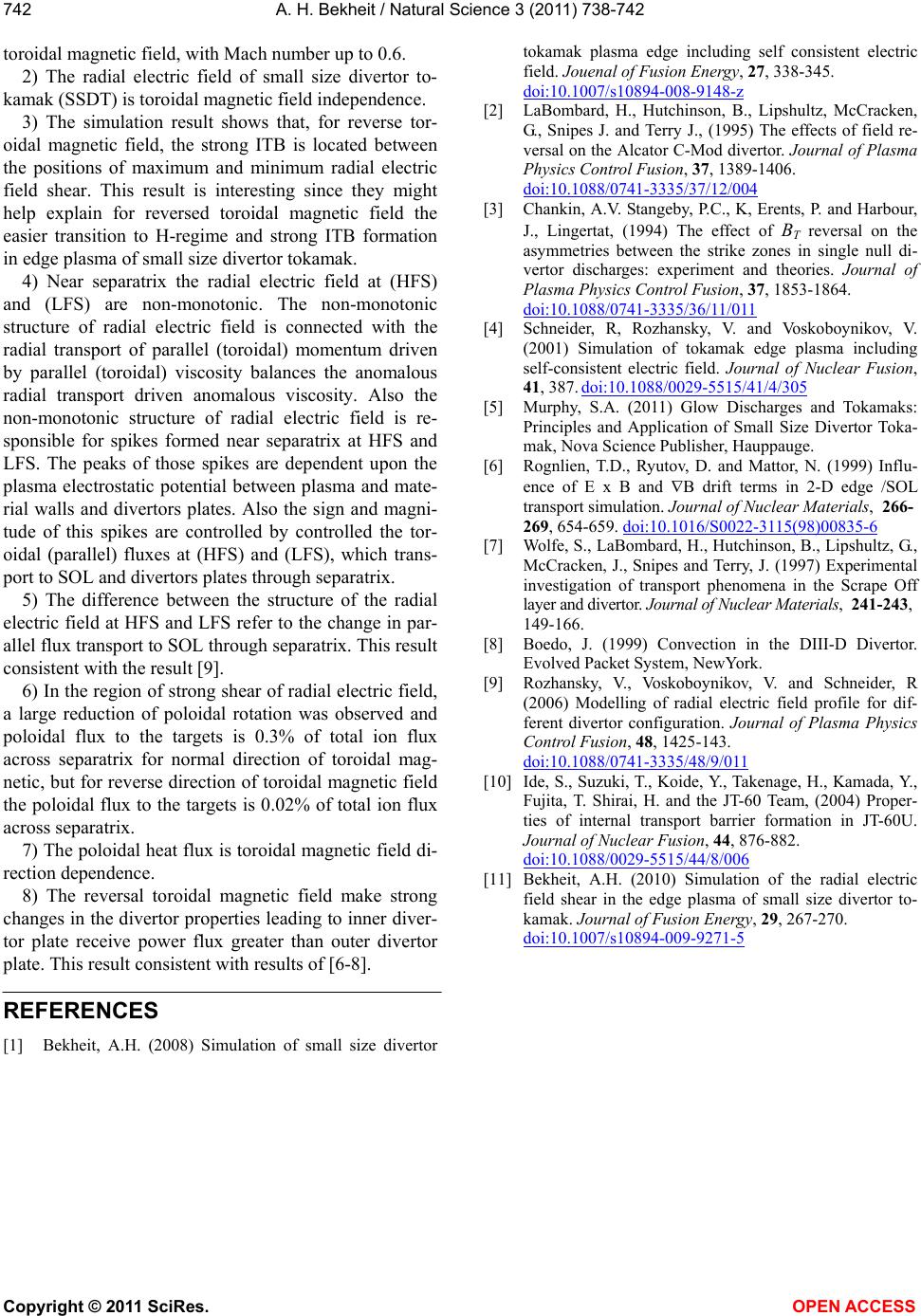
A. H. Bekheit / Natural Science 3 (2011) 738-742
Copyright © 2011 SciRes. OPEN ACCESS
742
toroidal magnetic field, with Mach number up to 0.6.
2) The radial electric field of small size divertor to-
kamak (SSDT) is toroidal magnetic field independence.
3) The simulation result shows that, for reverse tor-
oidal magnetic field, the strong ITB is located between
the positions of maximum and minimum radial electric
field shear. This result is interesting since they might
help explain for reversed toroidal magnetic field the
easier transition to H-regime and strong ITB formation
in edge plasma of small size divertor tokamak.
4) Near separatrix the radial electric field at (HFS)
and (LFS) are non-monotonic. The non-monotonic
structure of radial electric field is connected with the
radial transport of parallel (toroidal) momentum driven
by parallel (toroidal) viscosity balances the anomalous
radial transport driven anomalous viscosity. Also the
non-monotonic structure of radial electric field is re-
sponsible for spikes formed near separatrix at HFS and
LFS. The peaks of those spikes are dependent upon the
plasma electrostatic potential between plasma and mate-
rial walls and divertors plates. Also the sign and magni-
tude of this spikes are controlled by controlled the tor-
oidal (parallel) fluxes at (HFS) and (LFS), which trans-
port to SOL and divertors plates through separatrix.
5) The difference between the structure of the radial
electric field at HFS and LFS refer to the change in par-
allel flux transport to SOL through separatrix. This result
consistent with the result [9].
6) In the region of strong shear of radial electric field,
a large reduction of poloidal rotation was observed and
poloidal flux to the targets is 0.3% of total ion flux
across separatrix for normal direction of toroidal mag-
netic, but for reverse direction of toroidal magnetic field
the poloidal flux to the targets is 0.02% of total ion flux
across separatrix.
7) The poloidal heat flux is toroidal magnetic field di-
rection dependence.
8) The reversal toroidal magnetic field make strong
changes in the divertor properties leading to inner diver-
tor plate receive power flux greater than outer divertor
plate. This result consistent with results of [6-8].
REFERENCES
[1] Bekheit, A.H. (2008) Simulation of small size divertor
tokamak plasma edge including self consistent electric
field. Jouenal of Fusion Energy, 27, 338-345.
doi:10.1007/s10894-008-9148-z
[2] LaBombard, H., Hutchinson, B., Lipshultz, McCracken,
G., Snipes J. and Terry J., (1995) The effects of field re-
versal on the Alcator C-Mod divertor. Journal of Plasma
Physics Control Fusion, 37, 1389-1406.
doi:10.1088/0741-3335/37/12/004
[3] Chankin, A.V. Stangeby, P.C., K, Erents, P. and Harbour,
J., Lingertat, (1994) The effect of BT reversal on the
asymmetries between the strike zones in single null di-
vertor discharges: experiment and theories. Journal of
Plasma Physics Control Fusion, 37, 1853-1864.
doi:10.1088/0741-3335/36/11/011
[4] Schneider, R, Rozhansky, V. and Voskoboynikov, V.
(2001) Simulation of tokamak edge plasma including
self-consistent electric field. Journal of Nuclear Fusion,
41, 387. doi:10.1088/0029-5515/41/4/305
[5] Murphy, S.A. (2011) Glow Discharges and Tokamaks:
Principles and Application of Small Size Divertor Toka-
mak, Nova Science Publisher, Hauppauge.
[6] Rognlien, T.D., Ryutov, D. and Mattor, N. (1999) Influ-
ence of E x B and B drift terms in 2-D edge /SOL
transport simulation. Journal of Nuclear Materials, 266-
269, 654-659. doi:10.1016/S0022-3115(98)00835-6
[7] Wolfe, S., LaBombard, H., Hutchinson, B., Lipshultz, G.,
McCracken, J., Snipes and Terry, J. (1997) Experimental
investigation of transport phenomena in the Scrape Off
layer and divertor. Journal of Nuclear Materials, 241-243,
149-166.
[8] Boedo, J. (1999) Convection in the DIII-D Divertor.
Evolved Packet System, NewYork.
[9] Rozhansky, V., Voskoboynikov, V. and Schneider, R
(2006) Modelling of radial electric field profile for dif-
ferent divertor configuration. Journal of Plasma Physics
Control Fusion, 48, 1425-143.
doi:10.1088/0741-3335/48/9/011
[10] Ide, S., Suzuki, T., Koide, Y., Takenage, H., Kamada, Y.,
Fujita, T. Shirai, H. and the JT-60 Team, (2004) Proper-
ties of internal transport barrier formation in JT-60U.
Journal of Nuclear Fusion, 44, 876-882.
doi:10.1088/0029-5515/44/8/006
[11] Bekheit, A.H. (2010) Simulation of the radial electric
field shear in the edge plasma of small size divertor to-
kamak. Journal of Fusion Energy, 29, 267-270.
doi:10.1007/s10894-009-9271-5